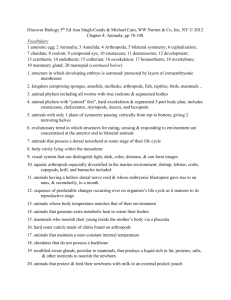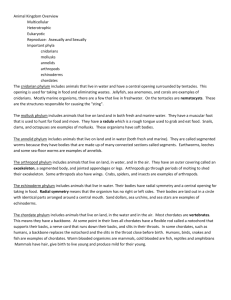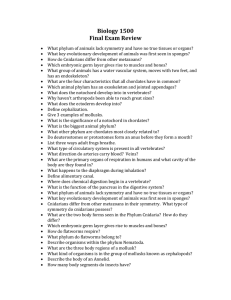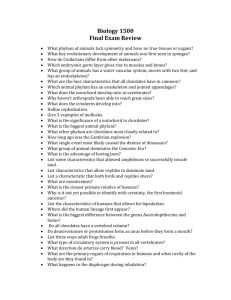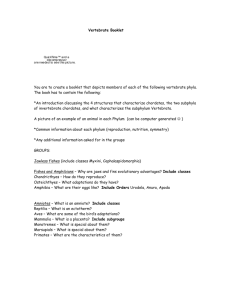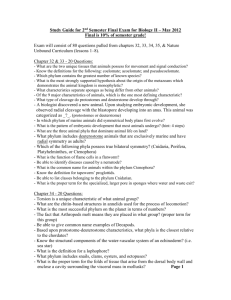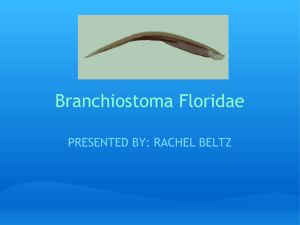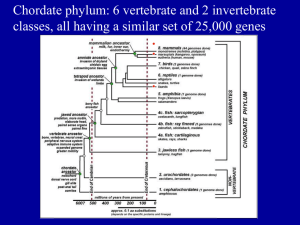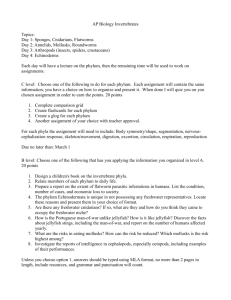Final Exam Review 2015
advertisement
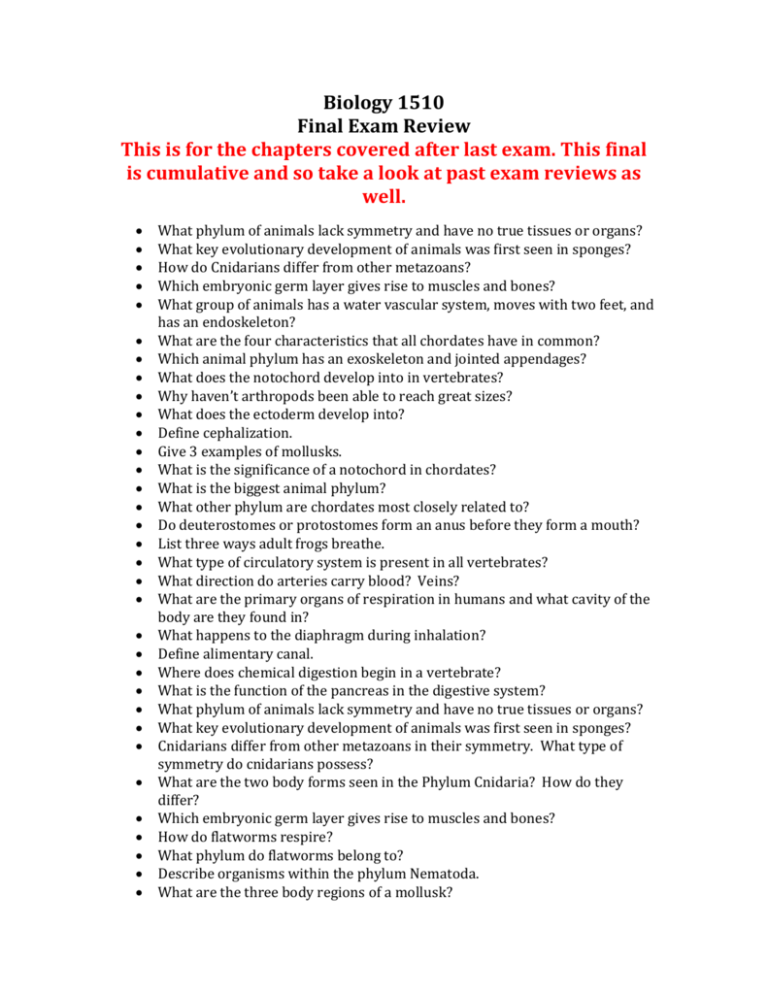
Biology 1510 Final Exam Review This is for the chapters covered after last exam. This final is cumulative and so take a look at past exam reviews as well. What phylum of animals lack symmetry and have no true tissues or organs? What key evolutionary development of animals was first seen in sponges? How do Cnidarians differ from other metazoans? Which embryonic germ layer gives rise to muscles and bones? What group of animals has a water vascular system, moves with two feet, and has an endoskeleton? What are the four characteristics that all chordates have in common? Which animal phylum has an exoskeleton and jointed appendages? What does the notochord develop into in vertebrates? Why haven’t arthropods been able to reach great sizes? What does the ectoderm develop into? Define cephalization. Give 3 examples of mollusks. What is the significance of a notochord in chordates? What is the biggest animal phylum? What other phylum are chordates most closely related to? Do deuterostomes or protostomes form an anus before they form a mouth? List three ways adult frogs breathe. What type of circulatory system is present in all vertebrates? What direction do arteries carry blood? Veins? What are the primary organs of respiration in humans and what cavity of the body are they found in? What happens to the diaphragm during inhalation? Define alimentary canal. Where does chemical digestion begin in a vertebrate? What is the function of the pancreas in the digestive system? What phylum of animals lack symmetry and have no true tissues or organs? What key evolutionary development of animals was first seen in sponges? Cnidarians differ from other metazoans in their symmetry. What type of symmetry do cnidarians possess? What are the two body forms seen in the Phylum Cnidaria? How do they differ? Which embryonic germ layer gives rise to muscles and bones? How do flatworms respire? What phylum do flatworms belong to? Describe organisms within the phylum Nematoda. What are the three body regions of a mollusk? What kind of organisms is in the group of mollusks known as cephalopods? Describe the body of an Annelid. How many body segments do insects have? What is the exoskeleton of an arthropod composed of? What group of animals has a water vascular system, moves with tube feet, and has an endoskeleton? What are the four characteristics that all chordates have in common? Which animal phylum has an exoskeleton and jointed appendages? What does the notochord develop into in vertebrates? Why haven’t arthropods been able to reach great sizes? What does the ectoderm develop into? Give and example of a Cnidarian with a medusa body form. Define cephalization. Give 3 examples of mollusks. Distinguish between a protostomes and a deuterostomes. What is the significance of a notochord in chordates? What is the biggest animal phylum? What other phylum are chordates most closely related to? Phylogeny Lab Review the different phyla discussed in class. o Porifera (sponges), Cnidaria, Platyhelminthes (flatworm), Nematoda, Annelida, Mollusca, Arhtropoda, Echinodermata, Chordata o Be able to describe the derived characteristics/evolutionary advancements seen in each phyla. Development of tissue Bilateral Symmetry Body Cavity Deuterostome development Segmentation/jointed appendages o Recognize representatives from each phyla. o Be able to interpret and construct a phylogenetic tree. Review character index: o Distinguish between radial and bilateral symmetry. o Distinguish between an endoskeleton and an exoskeleton. o What are the four embryological characteristics present in all chordates? Plant Lab Review the functions of the leaves, roots, stems, and fruits. Review the structure of the leaf observed in a cross section. o What are the tiny openings on the underside of most leaves that allow gas exchange and are also involved in transpiration? o What is the protective layer of the leaf? o What layer of the leaf is waxy? Which tissue in the leaf is responsible for photosynthesis? Review the cross section of the herbaceous dicot stem. o Locate the pith, xylem, phloem, and epidermis. Identify the five characteristics of a monocot and a dicot discussed in class. Review the flower anatomy. o Stamen- includes the filament and the anther. o Carpel- includes the stigma, style, and ovule. o Sepal o Petals Frog Dissection Review the internal anatomy of the frog. Heart, lungs, liver, gall bladder, stomach, sm. Intestines, lg. Intestines, bladder, anus, kidneys, ovaries, eggs, oviducts, sperm ducts, testes, pancreas, and spleen. List the structures through which food passes within a frog’s digestive tract beginning with mouth. There are 6 structures total. Review the location of the dorsal, ventral, anterior, and posterior sides of an organism.
